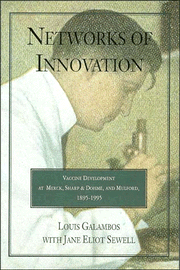Book contents
- Frontmatter
- Contents
- PREFACE
- 1 1894: “The foremost medical question of the day”
- 2 The Mulford Story
- 3 A Sharp & Dohme Interlude
- 4 The Virology Network and a New Program at Merck Sharp & Dohme
- 5 Hilleman's Innovations: First Phase
- 6 Dangerous Interlude
- 7 Transforming Bacteriology: A Second Phase
- 8 New Networks, New Leadership: The Hepatitis B Vaccines
- 9 Vaccine Innovation in the Nineties: New Strategies, New Opportunities, and Public Confrontations
- 10 Historical Perspectives on the Process of Innovation
- ACKNOWLEDGMENTS
- A WORD ABOUT SOURCES
- INDEX
- Plate section
5 - Hilleman's Innovations: First Phase
Published online by Cambridge University Press: 06 July 2010
- Frontmatter
- Contents
- PREFACE
- 1 1894: “The foremost medical question of the day”
- 2 The Mulford Story
- 3 A Sharp & Dohme Interlude
- 4 The Virology Network and a New Program at Merck Sharp & Dohme
- 5 Hilleman's Innovations: First Phase
- 6 Dangerous Interlude
- 7 Transforming Bacteriology: A Second Phase
- 8 New Networks, New Leadership: The Hepatitis B Vaccines
- 9 Vaccine Innovation in the Nineties: New Strategies, New Opportunities, and Public Confrontations
- 10 Historical Perspectives on the Process of Innovation
- ACKNOWLEDGMENTS
- A WORD ABOUT SOURCES
- INDEX
- Plate section
Summary
MAX TlSHLER and Merck's top executives were certain that they had found the right man to rev up the company's research in virology. But Maurice Hilleman's first venture at West Point was a failure – at least from the company's perspective. When the new director of Virus and Cell Biology Research arrived at the firm's laboratories, he discovered that Betty Hampil and two of her colleagues were continuing to work on the Salk polio vaccine. The vaccine was still unpredictable and its potency too variable. They were attempting to purify the virus, to use precise, standardized amounts of each serotype, and thus to obtain a vaccine of “uniform high potency.”
While one member of the research team, Jesse Charney, had discovered a novel way of precipitating the polio virus, the project was not moving ahead in a manner satisfactory to Hilleman. As he pushed forward with his efforts to reorganize and accelerate the work in virology, he took over direction of the Salk vaccine program. As that research progressed, Merck decided to concentrate its resources on this single program, leaving the production of oral Sabin vaccine to its competitors. After three years of additional research and clinical trials, Hilleman's team had a purified Salk vaccine that proved safe and effective in the clinical tests. The U.S. Public Health Service released Merck's new product for use by doctors in 1960.
But just as Purivax was nearing release, Hilleman and his coworkers made a startling discovery.
- Type
- Chapter
- Information
- Networks of InnovationVaccine Development at Merck, Sharp and Dohme, and Mulford, 1895–1995, pp. 79 - 122Publisher: Cambridge University PressPrint publication year: 1996



